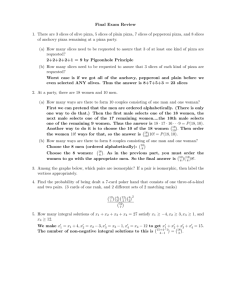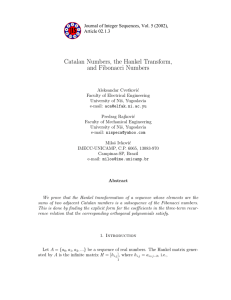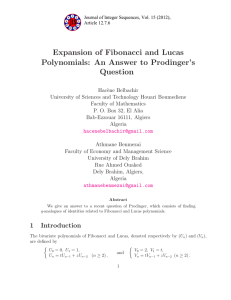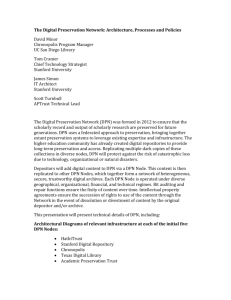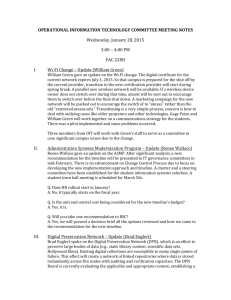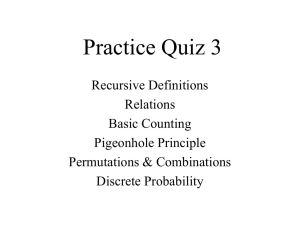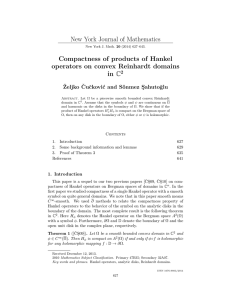A New Characterization of Catalan Numbers Numbers Belgacem Bouras
advertisement
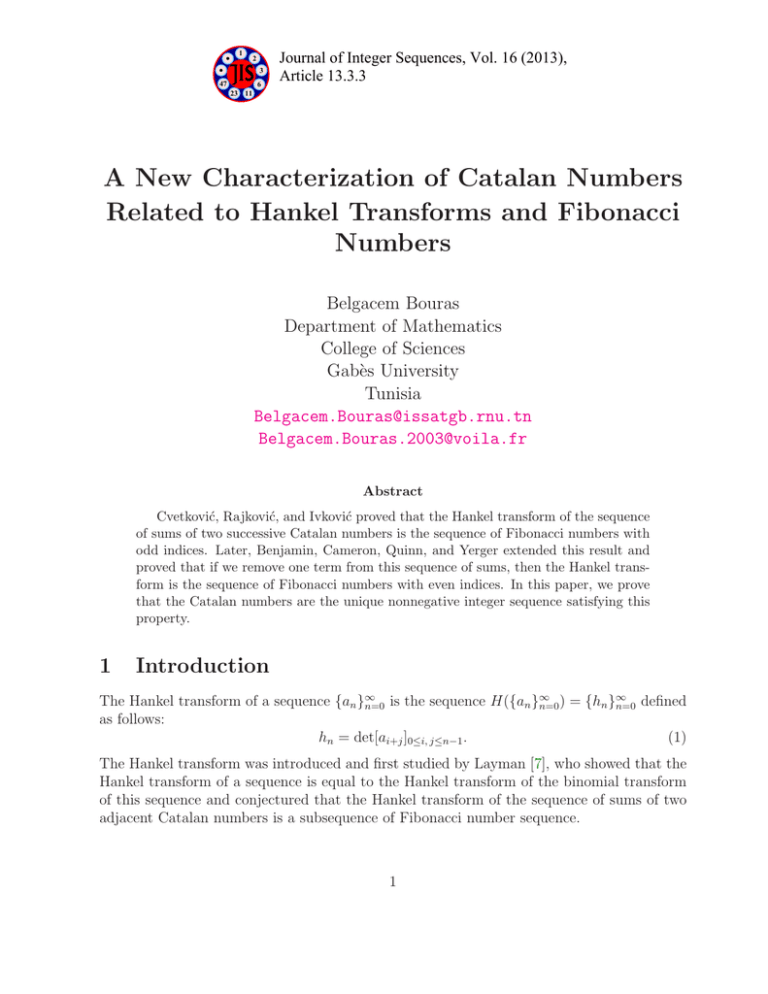
1
2
3
47
6
Journal of Integer Sequences, Vol. 16 (2013),
Article 13.3.3
23 11
A New Characterization of Catalan Numbers
Related to Hankel Transforms and Fibonacci
Numbers
Belgacem Bouras
Department of Mathematics
College of Sciences
Gabès University
Tunisia
Belgacem.Bouras@issatgb.rnu.tn
Belgacem.Bouras.2003@voila.fr
Abstract
Cvetković, Rajković, and Ivković proved that the Hankel transform of the sequence
of sums of two successive Catalan numbers is the sequence of Fibonacci numbers with
odd indices. Later, Benjamin, Cameron, Quinn, and Yerger extended this result and
proved that if we remove one term from this sequence of sums, then the Hankel transform is the sequence of Fibonacci numbers with even indices. In this paper, we prove
that the Catalan numbers are the unique nonnegative integer sequence satisfying this
property.
1
Introduction
∞
∞
The Hankel transform of a sequence {an }∞
n=0 is the sequence H({an }n=0 ) = {hn }n=0 defined
as follows:
hn = det[ai+j ]0≤i, j≤n−1 .
(1)
The Hankel transform was introduced and first studied by Layman [7], who showed that the
Hankel transform of a sequence is equal to the Hankel transform of the binomial transform
of this sequence and conjectured that the Hankel transform of the sequence of sums of two
adjacent Catalan numbers is a subsequence of Fibonacci number sequence.
1
Recall that the Catalan number sequence {Cn }∞
n=0 is defined as follows:
2n
Cn =
n
n+1
, n ≥ 0.
This sequence is the unique nonnegative integer sequence {an }∞
n=0 fulfilling (see [8])
det[ai+j ]0≤i, j≤n−1 = 1
and
det[ai+j ]1≤i, j≤n = 1.
Cvetković, Rajković, and Ivković [6] proved the following formula, known as Layman’s conjecture,
det[Ci+j+1 + Ci+j+2 ]0≤i, j≤n−1 = F2n+2 , n ≥ 1.
(2)
where Fn , n ≥ 0 is the n-th Fibonacci number defined by the following recurrence:
F0 = 0, F1 = 1, Fn+2 = Fn+1 + Fn , n ≥ 0.
(3)
The proof depends on special properties of the corresponding orthogonal polynomials. Benjamin, Cameron, Quinn, and Yerger [1] used a combinatorial approach and proved that
det[Ci+j + Ci+j+1 ]0≤i, j≤n−1 = F2n+1 , n ≥ 1.
(4)
In view of (4) and (2), it should be mentioned here that (4) and (2) are special cases of the
more general determinant evaluation given in [3].
A natural question arises: Is the Catalan number sequence the unique nonnegative integer sequence fulfilling (4) and (2)? More precisely, is there any other nonnegative integer
sequence {an }∞
n=0 fulfilling
det[ai+j + ai+j+1 ]0≤i, j≤n−1 = F2n+1 , n ≥ 1
(5)
det[ai+j+1 + ai+j+2 ]0≤i, j≤n−1 = F2n+2 , n ≥ 1.
(6)
and
The aim of this paper is to answer this question. Namely, we prove the main theorem of this
paper:
Theorem 1. The unique nonnegative integer sequence fulfilling (5) and (6) is the Catalan
number sequence.
Our paper is organized as follows: In Section 2, we state some basic results concerning
the theory of orthogonal polynomial. These results will be used in Section 3 to prove the
main theorem.
2
2
Notation and preliminary results
Let P be the vector space of polynomials with complex coefficients and let P ′ be its algebraic
dual. We denote by hu, f i the action of u ∈ P ′ on f ∈ P. In particular, we denote by
un = hu, xn i , n ≥ 0 the moments of u. If u ∈ P ′ and Φ ∈ P, then the left multiplication
of the functional u by the polynomial Φ, denoted by Φu, is the functional in P ′ defined as
follows:
hΦu, f i = hu, Φf i , f ∈ P.
(7)
Definition 2. (see [5]) A sequence of polynomials {Pn }n≥0 is said to be a monic orthogonal
polynomial sequence (MOPS) with respect to a linear functional u if
i) deg Pn = n and the leading coefficient of Pn (x) is equal to 1.
ii) hu, Pn Pm i = rn δn,m , n, m ≥ 0, rn 6= 0, n ≥ 0.
A linear functional u is called regular if there exists a polynomial sequence {Pn }n≥0 orthogonal with respect to u. Throughout this paper, we will take all regular linear functionals u
normalized, i.e., u0 = 1.
According to Favard-Shohat theorem, a sequence of monic orthogonal polynomials satisfies a three-term recurrence relation (see [5]):
P0 (x) = 1, P1 (x) = x − β0 ,
Pn+2 = (x − βn+1 )Pn+1 (x) − γn+1 Pn (x), n ≥ 0,
(8)
with
(βn , γn ) ∈ C × (C \ {0}), n ≥ 0.
3
Proof of the main theorem
First of all, recall that a linear functional L is regular if and only if (see [5])
∆n (L) 6= 0,
(9)
where ∆n (L) is the Hankel determinant of order n + 1 of L defined as follows:
L0 L1 · · · Ln L1 L2 · · · Ln+1 ∆−1 (L) = 1, ∆n (L) = ..
..
.. , n ≥ 0.
.
.
. Ln Ln+1 · · · L2n (10)
In this condition, the coefficient γn in (8) is given as follows (see [2, 5]):
γn+1 =
∆n+1 (L)∆n−1 (L)
, n ≥ 0.
∆2n (L)
(11)
Conversely, the Hankel determinant ∆n (L) can be written in terms of γn as follows (see [2]):
∆−1 (L) = ∆0 (L) = 1, ∆n (L) =
n
Y
k=1
3
τk , n ≥ 0,
(12)
where
τk =
k
Y
γi , k ≥ 1.
(13)
i=1
Let us recall a result established in [4] concerning the so-called kernel polynomials. Given a
MOPS {Pn }n≥0 orthogonal with respect to a linear functional L. The linear functional L∗
defined as follows:
L∗ = λ(x − c)L, c ∈ C,
where λ is a normalization factor, is regular if and only if
Pn (c) 6= 0, n ≥ 0.
In this case the MOPS corresponding to L∗ , denoted by {Pn∗ (c, x)}n≥0 , satisfies
Pn∗ (c, x) =
1
Pn+1 (c)
(Pn+1 (x) −
Pn+1 (x)).
x−c
Pn (c)
The sequence {Pn∗ (c, x)}n≥0 is called the sequence of kernel polynomials of K-parameter c
corresponding to {Pn }n≥0 . The recurrence coefficients of {Pn∗ (c, x)}n≥0 denoted by βn∗ and
∗
γn+1
are expressed in terms of those of {Pn }n≥0 as follows:
Pn+2 (c) Pn+1 (c)
−
,
Pn+1 (c)
Pn (c)
(14)
Pn+2 (c)Pn (c)
, n ≥ 0.
2
Pn+1
(c)
(15)
βn∗ = βn+1 +
∗
γn+1
= γn+1
Let {an }∞
n=0 be a non-negative integer sequence fulfilling (5) and (6). Then for n = 1, we get
a0 + a1 = F3 = 2 6= 0 and a1 + a2 = F4 = 3 6= 0. Define the linear functionals u, v and v ∗ by
un =
Cn + Cn+1
, n ≥ 0,
C0 + C1
(16)
vn =
an + an+1
, n ≥ 0,
a0 + a1
(17)
an+1 + an+2
, n ≥ 0.
a1 + a2
(18)
vn∗ =
From (10), (16) and (4), we have
∆n (u) =
F2n+3
, n ≥ 0.
(C0 + C1 )n+1
(19)
Using the recurrence (3), we can easily see that Fn 6= 0, n ≥ 0. Therefore, the condition (9)
is satisfied by u. Hence, u is regular. Similarly, from (10), (5), (6), (17) and the relation
(18), we get
F2n+3
∆n (v) =
, n≥0
(20)
(a0 + a1 )n+1
4
and
∆n (v ∗ ) =
F2n+4
, n ≥ 0.
(a1 + a2 )n+1
(21)
For the same reason, v and v ∗ are regular. We will denote by {Pn }n≥0 and {Pn∗ (c, x)}n≥0 the
MOPS corresponding to v and v ∗ respectively. From (17) and (18), we have
v∗ =
a0 + a1
xv.
a1 + a2
So, the sequence {Pn∗ (c, x)}n≥0 is the sequence of kernel polynomials of K-parameter 0 corresponding to {Pn }n≥0 . Hence, using (12), (13) and (15), with c = 0, we get
∆n (v ∗ ) =
Pn+1 (0)
∆n (v), n ≥ 0.
(P1 (0))n+1
Taking into account (20) and (21), we obtain
F2n+4 = (
a1 + a2 n+1 Pn+1 (0)
)
F2n+3 , n ≥ 0.
a0 + a1
(P1 (0))n+1
(22)
Suppose that {Pn }n≥0 satisfies the recurrence (8). We have
P1 (0) = −β0 .
But, from Definition 2 and the relation (8), we have
0 =< v, P1 P0 >=< v, P1 >=< v, x > −β0 < v, 1 >= v1 − β0 .
Thus
β0 = v1 =
a1 + a2
.
a0 + a1
P1 (0) = −
a1 + a2
.
a0 + a1
Therefore
(23)
Substitution of (23) in (22) gives
F2n+4 = (−1)n+1 Pn+1 (0)F2n+3 , n ≥ 0
or equivalently
Pn+1 (0) = (−1)n+1
F2n+4
, n ≥ 0.
F2n+3
(24)
From (11) and (20), we get
γn+1 =
F2n+5 F2n+1
, n ≥ 0.
2
F2n+3
Taking x = 0 in (8) and using (24) and (25), we get
βn+1 =
F2n+3 F2n+6 F2n+2 F2n+5
+
, n ≥ 0.
F2n+4 F2n+5 F2n+3 F2n+4
5
(25)
On account of the recurrence relation (3), we get
βn+1 =
F2n+4 F2n+3
+
, n ≥ 0.
F2n+3 F2n+5
(26)
We have proved that the recurrence coefficients of the MOPS corresponding to any sequence
∞
{an }∞
n=0 satisfying (5) and (6) are given by (25) and (26). Since the sequence {Cn }n=0 itself
satisfies (5) and (6) then the recurrence coefficients of its MOPS are also given by (25) and
(26). Consequently, by the uniqueness of the linear functional corresponding to a MOPS,
we have
u=v
or, equivalently,
un = vn , n ≥ 0.
Therefore, owing to (16) and (17), we obtain
an + an+1 = Cn + Cn+1 , n ≥ 0.
(27)
On the other hand, we have
a0 + a1 = F3 = 2.
Taking into account the fact that {an }∞
n=0 is a nonnegative sequence, we get a0 = 1 = C0
and a1 = 1 = C1 . By induction and using (27), we can easily prove that,
an = Cn , n ≥ 0.
Which completes the proof.
4
Acknowledgments
We are grateful to the anonymous referee for careful reading the text and essential remarks.
References
[1] A. T. Benjamin, N. T. Cameron, J. J. Quinn, and C. R. Yerger, Catalan determinants
— a combinatorial approach, Congr. Numer. 200 (2010), 27–34.
[2] B. Bouras, Generalized Jacobi orthogonal polynomials. Integral Transf. and Special
Functions, 18 (2007), 715–730.
[3] B. Bouras, Hankel determinant of a linear combination of three successive Catalan
numbers. Mediterr. J. Math. (In press).
[4] T. S. Chihara, On co-recursive orthogonal polynomials, Proc. Amer. Math. Soc., 8
(1957), 899–905.
6
[5] T. S. Chihara, An Introduction to Orthogonal Polynomials, Gordon and Breach, New
York, (1978)
[6] A. Cvetković, P. Rajković, and M. Ivković, Catalan numbers, and Hankel transform,
and Fibonacci numbers, J. Integer Seq. 5 (2002), Article 02.1.3.
[7] J. W. Layman, The Hankel transform and some of its properties, J. Integer Seq. 4
(2001), Article 01.1.5.
[8] R. P. Stanley, Enumerative Combinatorics, Vol. 1, Cambridge University Press, 1997.
[9] N. J. A. Sloane, The On-Line Encyclopedia of Integer Sequences. Published electronically at http://oeis.org.
2010 Mathematics Subject Classification: Primary: 33C45 ; Secondary 42C05.
Keywords: Hankel transform, Catalan number, recurrence relation, integer sequence.
(Concerned with sequences A000159, A014523, and A103433.)
Received July 11 2012; revised versions received October 23 2012; December 28 2012; February 3 2013. Published in Journal of Integer Sequences, March 2 2013.
Return to Journal of Integer Sequences home page.
7
